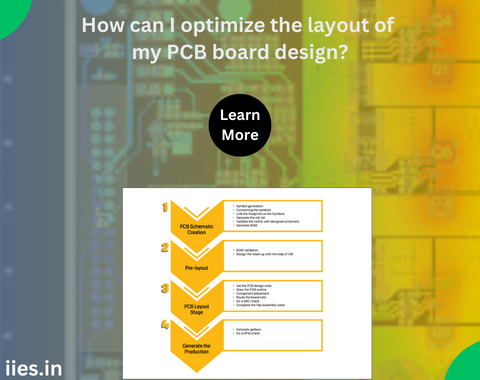
Printed Circuit Boards (PCBs) are the backbone of electronic devices, serving as the foundation for the seamless integration of various components. An optimized PCB layout is crucial for achieving peak performance, reliability, and efficient functionality. In this article, we will explore key strategies and considerations for optimizing the layout of your PCB board design.
Group similar functions together, minimize trace lengths, and place high-speed components closer to each other to reduce signal propagation delays. Additionally, consider thermal requirements when placing components to ensure effective heat dissipation.
One of the fundamental aspects of PCB layout optimization is strategic component placement. Carefully positioning components on the board can significantly impact signal integrity, thermal management, and overall performance.
Maintaining signal integrity is paramount for reliable electronic systems. To optimize signal integrity, it is essential to minimize signal distortion, crosstalk, and electromagnetic interference (EMI). Key practices include:
a. Trace Routing: Keep signal traces as short and direct as possible. Use wider traces for high-current paths and differential pairs to minimize impedance mismatches.
b. Ground Planes: Implement solid ground planes to provide a low-impedance return path for signals. This helps reduce ground loops and improves EMI performance.
c. Separation of Analog and Digital Signals: Isolate analog and digital signal paths to prevent interference. Place sensitive analog components away from noisy digital components.
d. Impedance Matching: Ensure impedance matching for transmission lines to prevent signal reflections. This is critical for high-speed designs.
Efficient power distribution is crucial for stable and reliable operation. Consider the following practices:
a. Decoupling Capacitors: Place decoupling capacitors close to power pins of active components to suppress voltage fluctuations. This ensures a stable power supply and reduces noise.
b. Power Plane Design: Use a dedicated power plane to distribute power across the PCB. This helps minimize voltage drops and improves overall power distribution.
c. Power Integrity: Analyze power integrity using tools like Power Delivery Network (PDN) analysis to identify and mitigate power distribution issues.
Overheating can lead to performance degradation and component failure. Effective thermal management is crucial for maintaining optimal operating temperatures. Consider the following thermal optimization techniques:
a. Heat Sinks: Use heat sinks for components that generate significant heat. Ensure proper placement and thermal coupling to dissipate heat efficiently.
b. Thermal Vias: Implement thermal vias to connect the top and bottom layers, improving heat dissipation. Place vias strategically to connect to ground or power planes.
c. Airflow Considerations: Design the PCB layout with airflow in mind. Ensure that components requiring cooling are positioned in a way that facilitates efficient heat dissipation.
Design for Manufacturability (DFM) and Design for Assembly (DFA):
Optimizing PCB layout also involves considerations for manufacturability and assembly. Strive for simplicity and clarity in the design to facilitate the manufacturing process.
a. Component Placement for Assembly: Place components in a way that simplifies the assembly process, reducing the risk of errors and improving efficiency.
b. Panelization: If applicable, design the PCB layout to facilitate panelization, streamlining the manufacturing process.
c. Clear Markings and Reference Designators: Ensure that all components are clearly labeled with reference designators to simplify assembly and troubleshooting.
Routing Techniques:
Efficient routing is essential for minimizing signal delays and ensuring a clean, organized design. Consider the following routing techniques:
a. Layer Stacking: Properly stack layers to optimize signal paths and reduce crosstalk. Use separate layers for power and ground to enhance signal integrity.
b. Avoidance of Right Angles: Minimize the use of right angles in traces, as they can lead to signal reflections. Use gentle curves or 45-degree angles for smoother signal paths.
c. Fanout Techniques: Use appropriate fanout techniques for components with high pin counts, such as BGAs, to optimize routing and ensure signal integrity.
For PCBs handling high-speed signals, additional considerations are crucial to maintaining signal integrity and preventing signal degradation. Key practices include:
a. Controlled Impedance Routing: High-speed signals, such as those in USB, HDMI, or DDR interfaces, require controlled impedance routing. Match the trace impedance to the characteristic impedance of the transmission line to minimize signal reflections and distortion.
b. SerDes Channel Routing: Serializer/Deserializer (SerDes) channels demand careful attention. Ensure differential pairs maintain consistent lengths, and utilize differential pair routing guidelines to minimize skew and crosstalk.
c. Ground Plane Splitting: In some cases, splitting the ground plane can help isolate sensitive analog or RF signals from digital noise. However, this should be done judiciously to avoid ground loops and maintain a low-impedance return path.
Electromagnetic Compatibility (EMC) and Electromagnetic Interference (EMI) are critical concerns in PCB design, especially in environments with stringent regulations. Implement the following measures to mitigate EMC/EMI issues:
a. Shielding: Integrate shielding techniques, such as copper shielding or conformal coatings, to contain electromagnetic emissions and prevent external interference.
b. Filtering Components: Use ferrite beads, common-mode chokes, and low-pass filters to suppress high-frequency noise and prevent it from propagating through the system.
Testing and Validation:
Optimizing the PCB layout doesn’t end with the design phase. Thorough testing and validation are crucial to ensuring the design meets performance criteria. Consider the following testing methodologies:
a. Signal Integrity Analysis: Utilize simulation tools to analyze signal integrity, crosstalk, and impedance matching. This helps identify potential issues before fabrication.
b. Thermal Analysis: Perform thermal simulations or use infrared imaging to validate the effectiveness of thermal management strategies. Ensure that critical components stay within their specified temperature limits.
Optimizing the layout of your PCB board design involves a holistic approach, considering various factors such as component placement, signal integrity, power distribution, thermal management, manufacturability, and routing techniques. By implementing these strategies and adhering to best practices, you can ensure that your PCB design not only meets performance requirements but also facilitates efficient manufacturing and assembly processes. A well-optimized PCB layout is a cornerstone for the success of electronic devices, providing the foundation for reliability, functionality, and overall system performance.
Indian Institute of Embedded Systems – IIES